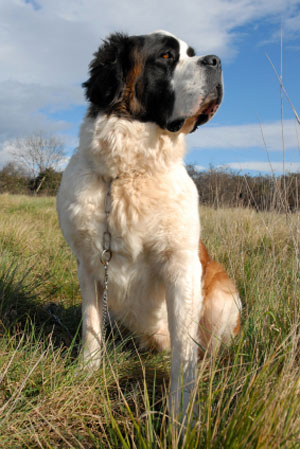
Facts
Care and exercise
Saint Bernards, like most giant breeds, require plenty of space where they can exercise themselves. As adults, they have great endurance but are not built for speed, so free-running, chasing and retrieving games are not for them. Puppies should be allowed to do their own thing, without forced exercise, while their bones, joints and ligaments are still developing. This is a breed where good nutrition is vital. Sufficient, but not excessive calcium, plenty of good quality protein and carbohydrates, vitamins and other minerals in balance are all essential to the successful rearing of St Bernards. Always ensure that the growing puppy (and indeed the adult) has enough to eat, but not so much that they get overweight.
Saints should always have soft bedding (and be encouraged to use it) to avoid developing pressure sores and calluses from lying on hard surfaces. Smooth coats, apart from the occasional wash, need only brushing or going over with a hound glove every couple of days. Roughs, with their bigger coats, need regular brushing with a stiff brush as well as the odd bath, which can be quite a job with so much dog to wash and rinse!
Suitability
A dog the size of the St Bernard needs room, lots of it. A big back yard and a large sleeping area are prime requirements. Its easygoing, gentle temperament suits this breed to most family situations, with it being at its happiest where there are children. Due regard must be given to its large food requirement and the difficulties involved in bathing and training.
This wonderful breed is well known as a people dog and will thrive in any loving environment.
One of the giants of the dog world, in every respect, known originally for its role in guiding and the rescue of travellers lost in snow and fog on the mountain passes of Switzerland in the 17th and 18th centuries, and given legendary status by J.M. Barrie as Nanny in that icon of childrens literature, Peter Pan & Wendy. A fully grown adult male St Bernard should reach around 80-90cm at the shoulder, and weigh about 120kg, with females slightly less. Their forearms are about the same thickness as an average mans. That’s big and, of course, a dog that size needs a fair bit of fuel, so feeding isn’t cheap.
Saints, as they are known, are very much people dogs, and despite their great size enjoy being part of the family and are usually very conscious of their bulk when moving within the house. They can be somewhat slobbery at times (like when there’s food around) so keep a towel handy!
In common with other giant breeds, the St Bernard is normally a gentle, placid, non-aggressive dog who knows its size but only makes use of it when pushed hard. Some adult males do not get on with others, for instance. Obedience training from the start is essential with any dog of this stature. This is another breed which comes in a choice of either rough or smooth coats, both with white as the base colour, and reddish-brown markings.







